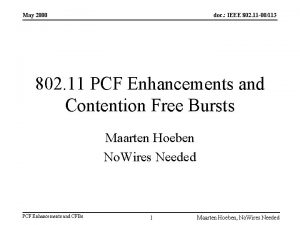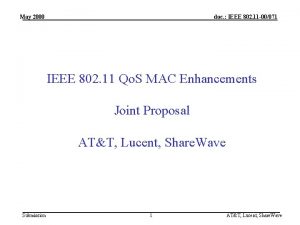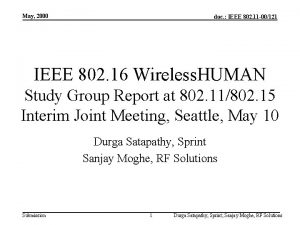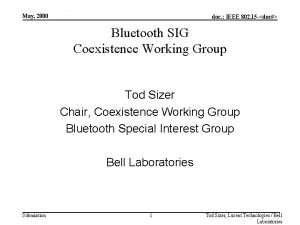May 2000 doc IEEE 802 15 doc Project






- Slides: 6

May 2000 doc. : IEEE 802. 15 -<doc#> Project: IEEE P 802. 15 Working Group for Wireless Personal Area Networks (WPANs) Submission Title: [TG 3 Selection Process Flow Chart] Date Submitted: [25 May 2000] Source: [James D. Allen] Company [Eastman Kodak Co. ] Address [66 Eastman Ave. Rochester, NY 14650 -2015] Voice: [(716) 227 -6346], FAX: [(716) 722 -9053], E-Mail: [james. d. allen@kodak. com] Re: [Call for Proposal Evaluation. ref 00110 r 10 P 802. 15] Abstract: [Flow chart of how the criteria will be used to evaluate proposals] Purpose: [This document communicates the results of TG 3 discussions on how to evaluate the proposal submissions. ] Notice: This document has been prepared to assist the IEEE P 802. 15. It is offered as a basis for discussion and is not binding on the contributing individual(s) or organization(s). The material in this document is subject to change in form and content after further study. The contributor(s) reserve(s) the right to add, amend or withdraw material contained herein. Release: The contributor acknowledges and accepts that this contribution becomes the property of IEEE and may be made publicly available by P 802. 15. Submission 1 James D. Allen, Eastman Kodak Co.

May 2000 doc. : IEEE 802. 15 -<doc#> Process Flow Diagram for P 802. 15. 3 Proposals DRAFT Submission 2 James D. Allen, Eastman Kodak Co.

May 2000 doc. : IEEE 802. 15 -<doc#> • This process was designed around several concerns expressed by TG participants: – Allow concepts to merge and optimize, – Need to hear all presentations before vote even if materials are available in advance (Q/A sessions) – Need to reduce number of options quickly – Need to use TG 3’s joint expertise efficiently – Need to be able to consider new criteria – Need to have a streamlined process compatible with informed voters, short schedules and conference calls – Need to prevent getting lost in the process rather than focused on the goal Submission 3 James D. Allen, Eastman Kodak Co.

May 2000 File Submission to TG 3 Secretary, Copy to Chair Voting worksheets passed out @ July Meeting doc. : IEEE 802. 15 -<doc#> Secretary: Assigns Document Number if missing Verifies Format and Copyright Release Scans for meeting PAR Scans for Self Rating Section Verify slot in July calendar Notify Alfvin or Gifford for web matrix Forward to Gifford for posting Remind Submitter of presentation date/time and request any missing data Updates Chair on status [All presentations and support documents are available before Monday. ] One Pugh matrix per submission is passed out to voters before presentations at a session This vote is for “first order” ordering of submissions Voter may vote in ordering process only if present for the session ( a session my have >1 presentation) Votes are handed in at end of each session Submitter Presents at July IEEE Meeting Submission 4 James D. Allen, Eastman Kodak Co.

May 2000 Rank order all Presentations Criteria Changes Conference Call Analysis Cycle Submission doc. : IEEE 802. 15 -<doc#> Voters rate relative (+, same, -) for each criteria during presentation. Voters to covert self rating details to general Pugh ratings Weighting is applied in Pugh tool to help separate criteria value Acceptable value for each criteria item used as reference (all proposals rated relative to this) Presentations are put in order of rating - THERE IS NO SORTING DONE AT THIS TIME Order will determine evaluation order Time to hear, think, discuss, evolve is needed prior to a first sort vote Evaluate any proposals to change Criteria Vote on changes Thursday - has to be during Plenary Request reassessment of any new criteria by all submitters Publish Con Call discussion schedule (week following July meeting) Conference Call discussions of all proposals Focus on filling in matrix, asking questions, Sequence is in order of first order vote Pugh “+same-” evaluation will be completed Evaluate Mac and Phy separate- each containing Systems sections and combinations or improvements of proposals to encourage best solutions final proposal No Mac or Phy exist alone. Phy -only or Mac-only submissions must be paired for final vote in Sept. 5 James D. Allen, Eastman Kodak Co.

May 2000 September Meeting Next level of Sort Reduce to one Phy/Mac doc. : IEEE 802. 15 -<doc#> Review matrix and analysis results and vote on acceptance of work. Vote on which proposals to pursue 1 - Use master evaluation document which is the matrix from doc 00110 P 802. 15 as the reference. 2 - Each voter rates all proposals in order of preference - each proposal is given a number of their order (first choice is 1, etc) 3 - Votes are tallied, results are presented and sanity check done informally 4 - Top half stays in, bottom half is excused. 5 - Top half has the opportunity to discuss differences to clarify 6 - Vote is taken again If preferred solution is not obvious, 1 - review details of surviving proposals in more depth 2 - discuss impact of decision on events out side of TG 3 (not currently a criteria) 3 - Refine how number weights are used in the selection matrix 4 - Revote Establish method for reducing remaining proposals to final drafts for PHY/MAC 1 - review criteria and weighting for final selection 2 - rate each remaining proposal based on final criteria 3 - determine proposal differences and evaluate against PAR and criteria 4 - vote to determine final proposal for PHY/MAC 5 - create baseline PHY/MAC drafts from results Begin Draft Standard Submission 6 James D. Allen, Eastman Kodak Co.











